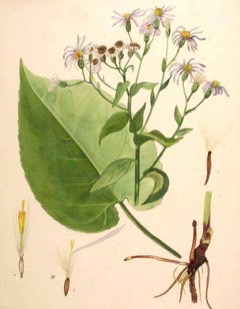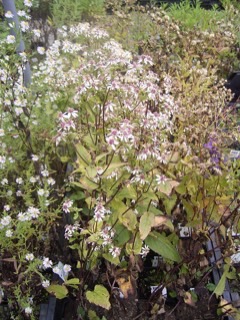 |
|
edibleplants.org |
 |
| kwekerij esveld wikimedia.org |
Translate this page:
Summary
Aster divaricatus L. is a synonym of Eurybia divaricata (L.) G.L.Nesom
Physical Characteristics

 Eurybia divaricata is a deciduous Perennial growing to 0.9 m (3ft) by 0.9 m (3ft in) at a fast rate.
Eurybia divaricata is a deciduous Perennial growing to 0.9 m (3ft) by 0.9 m (3ft in) at a fast rate.
See above for USDA hardiness. It is hardy to UK zone 5.
It is noted for attracting wildlife.
Suitable for: light (sandy), medium (loamy) and heavy (clay) soils and prefers well-drained soil. Suitable pH: mildly acid and neutral soils. It can grow in full shade (deep woodland) semi-shade (light woodland) or no shade. It prefers dry or moist soil.
UK Hardiness Map
US Hardiness Map
Synonyms
Aster divaricatus. Aster boykinii E.S.Burgess. Aster carmesinus E.S.Burgess. Aster castaneus E.S.Burgess. Aster claytonii E.S.Burgess. Aster corymbosus Sol. ex Aiton. Aster divaricatus L. Aster elatus Bertero ex Steud. Aster excavatus E.S.Burgess. Aster fischeri Kuntze. Aster flexilis E.S.Burgess. Aster stilettiformis E.S.Burgess. Aster tenebrosus E.S.Burgess. Biotia corymbosa var. alata (W.P.C.Barton) DC. Eurybia corymbosa (Sol. ex Aiton) Cass.
Plant Habitats
Edible Uses
Edible Parts: Leaves
Edible Uses:
The young leaves of the plant can be cooked and eaten.
References More on Edible Uses
Medicinal Uses
Plants For A Future can not take any responsibility for any adverse effects from the use of plants. Always seek advice from a professional before using a plant medicinally.
None Known
References More on Medicinal Uses
The Bookshop: Edible Plant Books
Our Latest books on Perennial Plants For Food Forests and Permaculture Gardens in paperback or digital formats.

Edible Tropical Plants
Food Forest Plants for Hotter Conditions: 250+ Plants For Tropical Food Forests & Permaculture Gardens.
More

Edible Temperate Plants
Plants for Your Food Forest: 500 Plants for Temperate Food Forests & Permaculture Gardens.
More

More Books
PFAF have eight books available in paperback and digital formats. Browse the shop for more information.
Shop Now
Other Uses
Shade/Semi-shade in woodland gardens. Grow and flower in dry shade. Fragrant Blooms. Ornamental - flowering earlier than many other asters. Invertebrates shelter: beneficial for insects and other arthropods. Nectary: provides nectar or pollen for beneficial insects [1-2]. Attractive to butterflies.
Special Uses
Food Forest
References More on Other Uses
Cultivation details
A spreading rhizome herbaceous Perennial flowering earlier than many other asters. Flowers are small but abundant (to 1 inch across). It needs average, dry to medium, well-drained soil in sun, part shade to full shade. Thrives in shade and tolerates dry conditions. Prefers shade to sun. Growth Habit: Clump-forming. Flowering Period: Aug to Oct. Flower Colour: White. Flower: Showy. Time to full growth: 2 to 5 years. Little problem with both disease and insects. For polyculture design as well as the above-ground architecture (form - tree, shrub etc. and size shown above) information on the habit and root pattern is also useful and given here if available. The plant growth habit is a clumper with limited spread [1-2]. The root pattern is fibrous dividing into a large number of fine roots [1-2]. The root pattern is stoloniferous rooting from creeping stems above the ground [1-2]. The plant is heat tolerant in zones 9 through 1. (Plant Hardiness Zones show how well plants withstand cold winter temperatures. Plant Heat Zones show when plants would start suffering from the heat. The Plant Heat Zone map is based on the number of "heat days" experienced in a given area where the temperature climbs to over 86 degrees F (30°C). At this temperature, many plants begin to suffer physiological damage. Heat Zones range from 1 (no heat days) to 12 (210 or more heat days). For example Heat Zone. 11-1 indicates that the plant is heat tolerant in zones 11 through 1) .
References Carbon Farming Information and Carbon Sequestration Information
Temperature Converter
Type a value in the Celsius field to convert the value to Fahrenheit:
Fahrenheit:
The PFAF Bookshop
Plants For A Future have a number of books available in paperback and digital form. Book titles include Edible Plants, Edible Perennials, Edible Trees,Edible Shrubs, Woodland Gardening, and Temperate Food Forest Plants. Our new book is Food Forest Plants For Hotter Conditions (Tropical and Sub-Tropical).
Shop Now
Plant Propagation
Propagate by division in spring.
Other Names
If available other names are mentioned here
White star aster, White wood aster, wood aster, Eurybia divaricata, Aster divaricatus
Native Range
NORTHERN AMERICA: Canada, Ontario (south), United States, Maine, Massachusetts, New Hampshire, New York, Ohio, Pennsylvania, Rhode Island, Vermont, West Virginia, Colorado, Alabama, Delaware, Georgia, Kentucky, Maryland, North Carolina, South Carolina, Tennessee, Virginia (southwest), District of Columbia,
Weed Potential
Right plant wrong place. We are currently updating this section.
Please note that a plant may be invasive in one area but may not in your area so it's worth checking.
None Known
Conservation Status
IUCN Red List of Threatened Plants Status :

Growth: S = slow M = medium F = fast. Soil: L = light (sandy) M = medium H = heavy (clay). pH: A = acid N = neutral B = basic (alkaline). Shade: F = full shade S = semi-shade N = no shade. Moisture: D = dry M = Moist We = wet Wa = water.
Now available:
Food Forest Plants for Mediterranean Conditions
350+ Perennial Plants For Mediterranean and Drier Food Forests and Permaculture Gardens.
[Paperback and eBook]
This is the third in Plants For A Future's series of plant guides for food forests tailored to
specific climate zones. Following volumes on temperate and tropical ecosystems, this book focuses
on species suited to Mediterranean conditions—regions with hot, dry summers and cool, wet winters,
often facing the added challenge of climate change.
Read More
Expert comment
Author
(L.) G.L.Nesom
Botanical References
Links / References
For a list of references used on this page please go here
Readers comment
| Add a comment |
|
If you have important information about this plant that may help other users please add a comment or link below. Only comments or links that are felt to be directly relevant to a plant will be included. If you think a comment/link or information contained on this page is inaccurate or misleading we would welcome your feedback at [email protected]. If you have questions about a plant please use the Forum on this website as we do not have the resources to answer questions ourselves.
* Please note: the comments by website users are not necessarily those held by PFAF and may give misleading or inaccurate information.
To leave a comment please Register or login here All comments need to be approved so will not appear immediately.
|
Subject : Eurybia divaricata
|
|
|
|